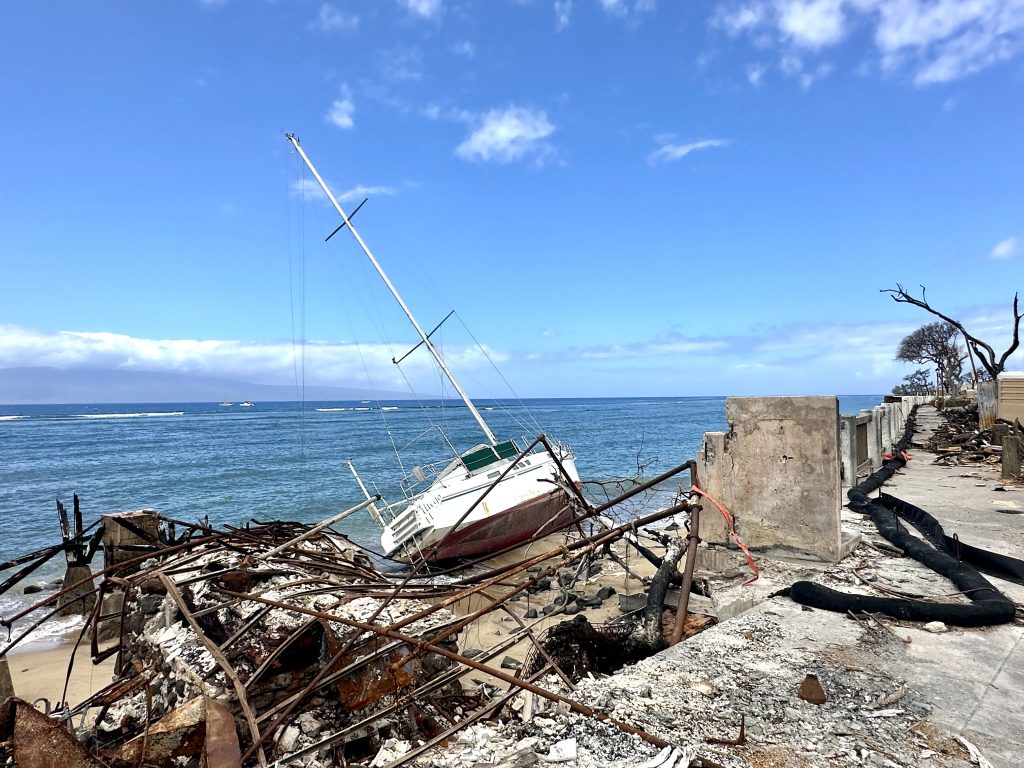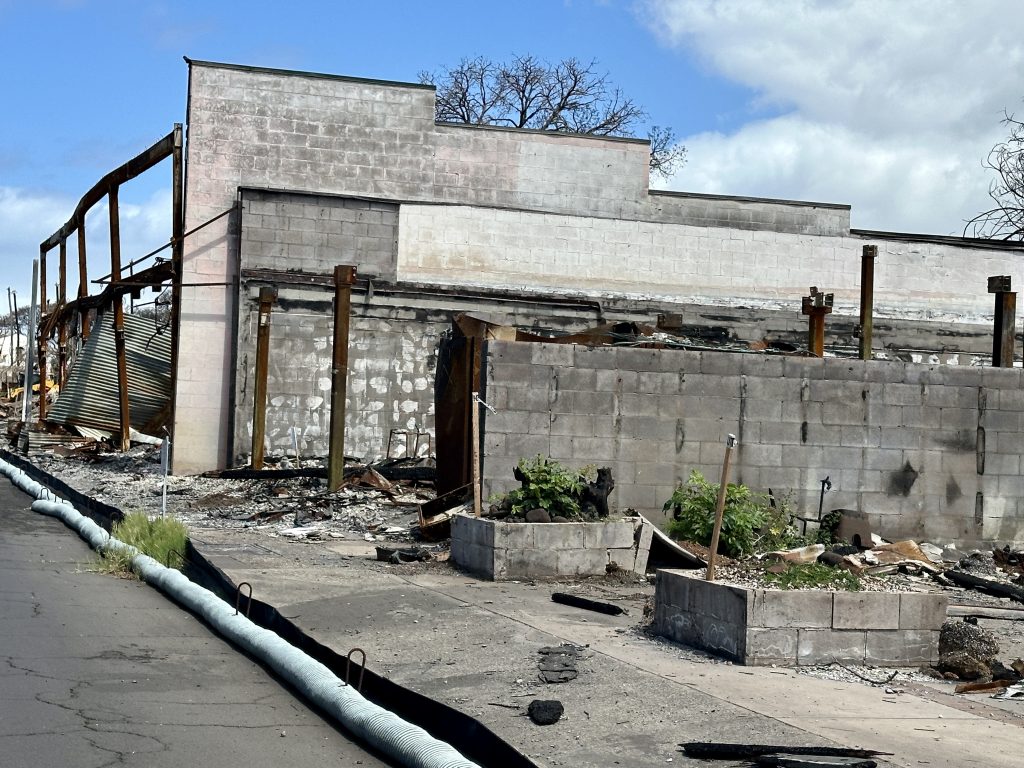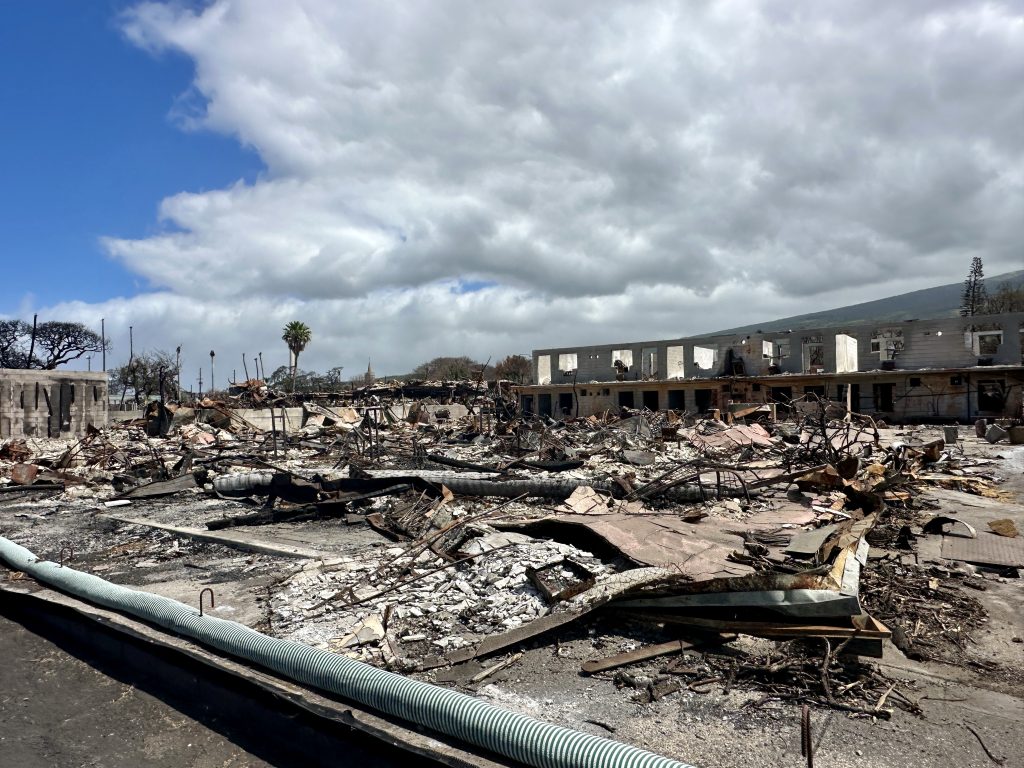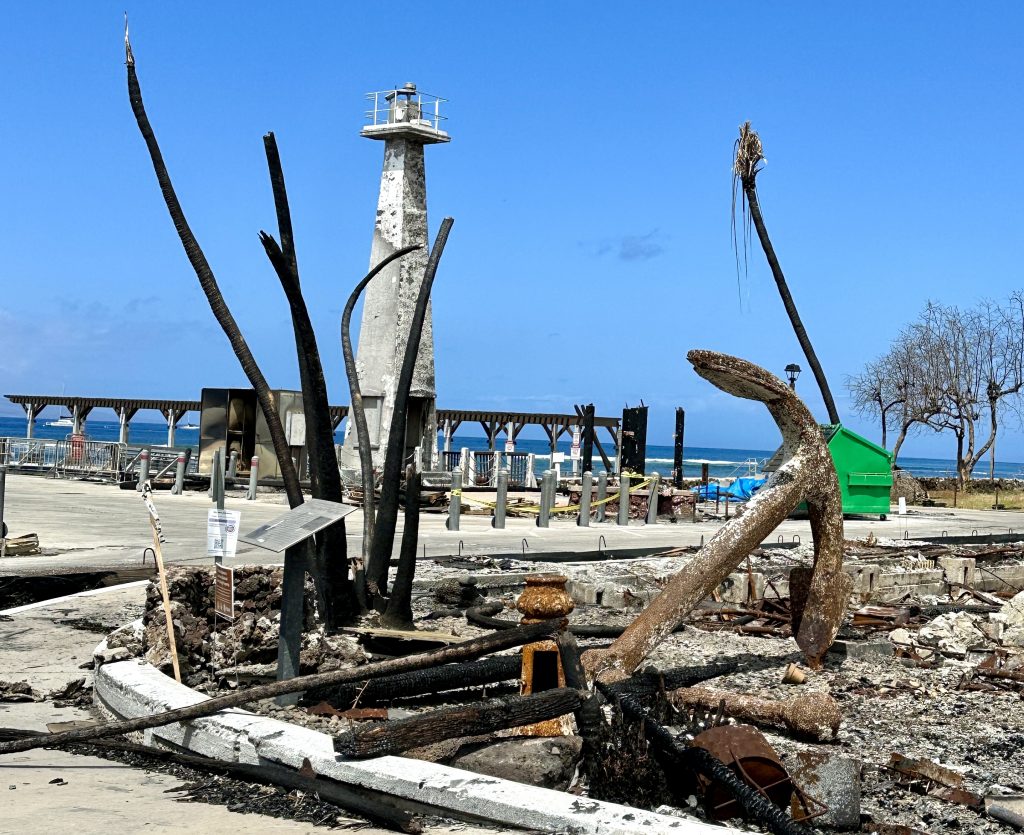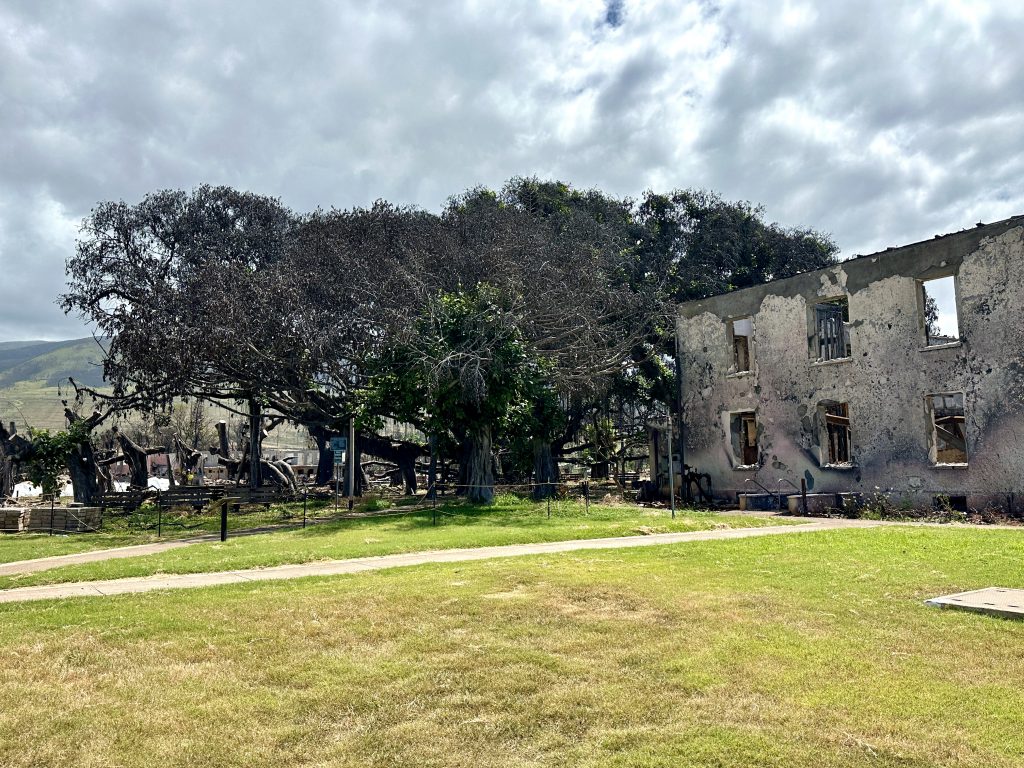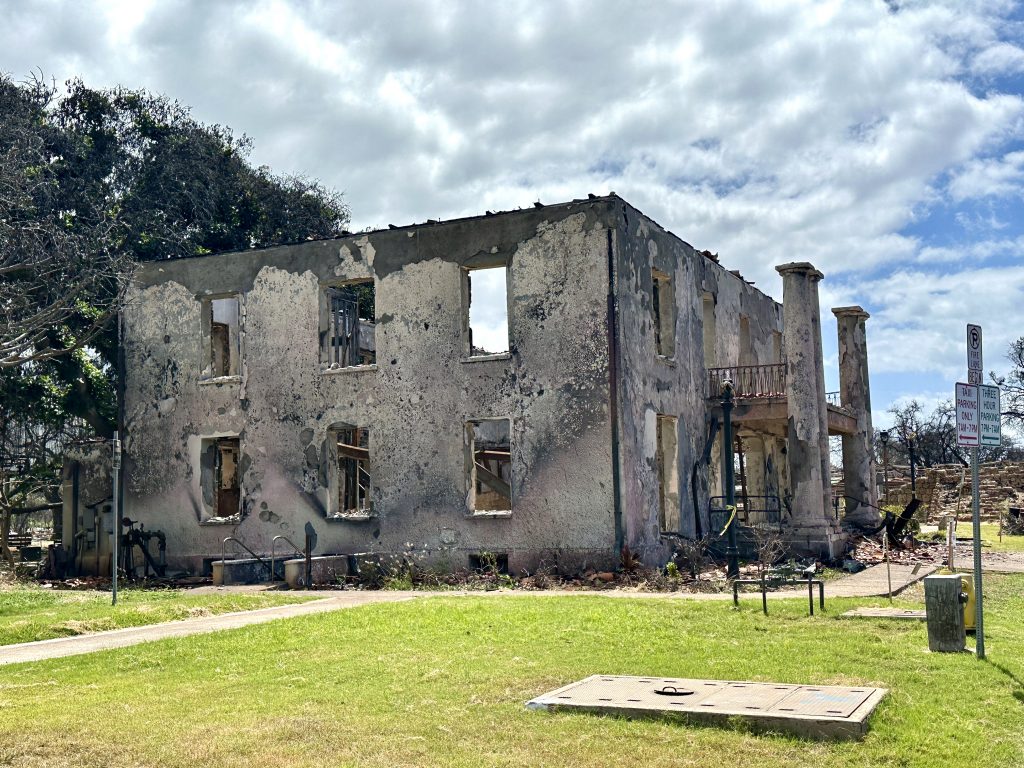Council Budget Committee hears the pain of Lahaina wildfire survivors

Eight months to the day after a wildfire swept through Lahaina town, Maui County Council members heard the anguish of residents struggling to rebuild their lives after the disaster that claimed at least 101 lives and leveled their beloved historic town.
Lahaina resident Mike Whitehead told Budget, Finance and Economic Development Committee members that he can’t stop thinking about the number of people who died and how evacuation efforts fell short after water ran out of firefighters’ fire hoses.
“Why wasn’t nobody going around all over Lahaina just telling people evacuate, there’s no water?” he asked. “Things like that go through all of our heads right now. And we’re still stressed out.”
“You know we maybe go to work, almost eight months now for the fire,” he said. “We put a smile on. We go to work. It doesn’t mean things are great for us. We’re stressing out. I know because I stress every day.”
Rick Nava asked Budget Committee members reviewing Mayor Richard Bissen’s proposed $1.67 billion fiscal 2025 budget to prioritize public health and safety and the community’s lack of parks and open space for children who need a place to run and play.
“We need to find a way to prevent fire from happening,” Nava said. “People are still freaking out about the condition that we’re in… What happened was a perfect storm. I lost my home. Thank God I did not lose some my family members.

“We’re all scared,” he said. “We hear the wind. We hear a siren going off. It’s very uncomfortable.”
Shannon Lʻi took note of the low resident turnout (approximately 70 people) at Monday’s meeting.
“Today marks eight months,” she said. “And so for me it was a really hard day. So I think for a lot of people it’s hard to show up and even share or process even what’s going on, and think about budget when there’s other things.”
Junya Nakoa said government efforts to respond to residents’ needs, especially for affordable housing located in Lahaina, have fallen far short.
“We getting screwed!” he shouted. “I hope you guys going to help us out.”
Nakoa said housing for wildfire survivors has been used as an excuse to justify nearly $30 million in county funding for affordable housing projects “on the other side of the island.”
“Oh, yeah, go put the Lahaina wildfire guys over there,” he said. “I’m mad. I’m pissed off… Please help us out.”
Several of more than two dozen testifiers spoke about the West Maui community’s desperate need for affordable housing, as well requests for support for the Lahaina Community Land Trust. It is a newly formed nonprofit that aims to protect Lahaina lands and prioritize the community’s well-being over profit by offering a community-based alternative to landowners considering the sale of their land to outside investors.
Whitehead said he sees email lists for foreclosures in Lahaina. “Where are all these lists coming from?” he asked. “I know a lot of friends who moved to the Mainland because they just can’t deal with it. We’re being bought out, by who? Nobody’s watching us, really, or protecting us on this side.”
Lʻi said the Kaiāulu O Kupuohi and Pulelehua affordable housing projects are ready for construction in West Maui.
“It’s really important to fund projects that are shovel ready here in West Maui,” she said. “There’s all these other projects on the other side of the island, and, again, we’re grateful for the help but really I feel like, again, it’s off of the backs of this wildfire.”
“The people who are struggling the most don’t have the opportunity to stay where we belong,” she said. “We belong here. I am a ninth generation family, and I don’t want move out of my home.”
After more than eight months, the US Army Corps of Engineers has begun removing ash and debris from Lahaina, hauling truckloads to a temporary disposal site at Olowalu. However, much of the historic town remains in ruins.
In his March 15 State of the County Address, Mayor Bissen said his administration is focused on returning Lahaina residents to their properties and prioritizing the restoration of critical infrastructure.
West Maui housing projects such as Kaiāulu o Kupuohi and Kaiāulu o Kūkuʻia “are advancing,” Bissen said, “and once the expedited permitting office begins operating next month, we expect to see more progress.”
The mayor said he also redirected more than $4 million in Community Development Block Grant funds toward the acquisition of eight units for permanent, affordable rental housing opportunities for kūpuna displaced by the fires.
At Monday’s meeting, former West Maui Council Member Jo Anne Johnson Winer asked council members to give tax relief to fire-impacted residents with limited incomes.
She said her own home’s valuation went up by $300,000 and increasing her property tax rate from $1.90 to $2.50 per $1,000 in the Mayor’s budget would double her property tax bill, even with the homeowner’s exemption.
“I can take my savings and pay that bill,” she said. But she asked council members to consider “those who have already gone through their savings, or never had any savings to begin with because they’re living paycheck to paycheck.”
She also asked council members to keep in mind other people who might get overlooked.
“What about the business owner who lost his income because the building burned and he didn’t own it?” she asked. “Or how about the business owner who barely survived COVID lockdown and now is facing a huge downturn in the business where insurance doesn’t help? What about the employee who worked in Lahaina and is paying a mortgage on a home in Nāpili and has not been able to find a job? How about the retiree who has limited income and can barely pay for food, medication and insurance, let alone taxes?”
“You will not be able to restore Lahaina if the residents are forced to leave because they are taxed out of the place that they have always called home,” Johnson Winer said. “Give consideration on the consequences to those who are vulnerable and already suffering.”
Kiley Adolpho, who helps provide families with basic needs with the mobile Kelawea Mauka Community Hub, called for support for the Lahaina Community Land Trust and said people are fending for themselves, finding “creative ways to bypass some of the red tape.”
“I hear all their stories,” she said. “We shouldn’t as a community have to find all these creative ways to bypass all of these things so that people can be safe. We’re asking you to do it for us and be strong.”
Adolpho expressed pain at the loss of “kūpuna who died because they didn’t have a good emergency management plan to get them out of there.”
“The Lahaina people need your help,” she told council members. “Use your power. Use your name. Use your title. Use your family, your friends, your cousins, whoever is up there to do what we need to do. We are disappearing from the news, but we need the help.”
Community activist Kai Nishiki said wildfire survivor rent subsidies from the Federal Emergency Management Agency will run out eventually, and a range of affordable housing options are needed in West Maui. She pointed out that 87% of Lahaina’s displaced people were renters, not homeowners.
“Those folks will likely not be able to even afford (housing) if former rentals are rebuilt,” Nishiki said. “Because renting an add-on to somebody’s garage, or a room in a plantation home, that is not what is going to be available. It is going to be out of reach for so many.”
“The foundation of economic recovery is housing,” she said. “People need to feel safe. They need to have a place that is home base for their families. And, people really need pet-friendly rentals available. We cannot abandon our furry children to then have housing. People would rather live in their cars or live on the beach than abandon their pets.”
Nishiki reminded council members that Ka Hale A Ke Ola Homeless Resource Centers lost its 78-unit Lahaina homeless shelter in the fire, and people without housing are living in encampments in places like Cut Mountain, which she visited Monday. The site has the strong odor of feces, and there are children, dogs and cats, and abandoned vehicles, she said.
“Our unsheltered population is growing every day,” she said. “Cut Mountain has no fire protection. It has no bathroom facilities. The brush is higher than us as we were walking through there.”
Nishiki said people living at Cut Mountain include those who can’t keep their family pets at hotels.
“It is a really harsh environment,” she said. “And, you know, it’s not because they want to be there, it’s because they have no place else to go.”

Whitehead bristled at each testifier being given a three-minute time limit for testimony.
“We’re here on our time. You guys are getting paid,” he told council members, and suggested that low resident turnout at Monday’s meeting was because people did not have faith that their concerns would be heard.
“Why even testify?” he asked. “Because nobody can get out their feelings in three minutes. Nobody can speak about what they want.”
After his testimony, Budget Committee Chair Yuki Lei Sugimura said the Council’s rules and conduct of its meetings are bound by the state Sunshine Law.
Other testimony on Monday was in support of Maui Economic Opportunity programs, including transportation and Head Start; and for more public pickleball courts at county parks.
The Budget Committee’s next community meeting is at 6 p.m. Thursday at the Kīhei Community Center, followed by 6 p.m. April 15 at the Mitchell Pauʻole Community Center in Kaunakakai and a public hearing by the full Council at 6 p.m. April 23 in the eighth-floor Council Chambers of the Kalana O Maui Building in Wailuku.
Written testimony is accepted via eComment. Visit mauicounty.us/agendas, click on the eComment link, then select the agenda item to submit comments on.
For more information on testifying, go to www.mauicounty.us or contact the Office of Council Services at 808-270-7838.





